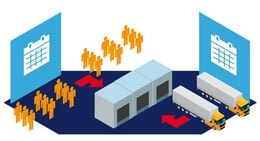Integrated Business Planning: The Future of S&OP?
Nick Ostdick - April 21, 2016

 In part one of our series on sales and operations planning, we looked at traditional S&OP models and solutions and discussed the benefits and competitive advantages companies can leverage by properly executing a robust S&OP strategy. In the end, we concluded companies without a fully-realized S&OP solution are not only behind the times, but are also effectively playing a game of Russian Roulette when it comes to cost-effective decision-making and maximizing profitability.
In part one of our series on sales and operations planning, we looked at traditional S&OP models and solutions and discussed the benefits and competitive advantages companies can leverage by properly executing a robust S&OP strategy. In the end, we concluded companies without a fully-realized S&OP solution are not only behind the times, but are also effectively playing a game of Russian Roulette when it comes to cost-effective decision-making and maximizing profitability.
However, for many in the manufacturing and supply game, the keyword there is traditional, especially as more and more companies move away from S&OP principles to the more dialed-in and versatile IBP (Integrated Business Planning) model.
While still somewhat in its infancy in terms of acceptance and mass-implementation in the supply stream, IBP has quickly become a talking point for industry insiders and an important element of overall strategic planning that companies must seriously consider in today’s expanding, global manufacturing and supply network.
Definition
Nailing down a widely-accepted definition of IBP is perhaps one of the most interesting and complex conversations in manufacturing and supply today. Opinions vary on whether IBP is a natural extension of evolution of S&OP solutions, or whether IBP is its own animal entirely as the principles and elements stray far enough from S&OP that many companies, managers, and planners have admitted in a number of recent surveys they don’t fully grasp its concepts.
Part of the controversy stems from the way IBP differentiates itself from S&OP by accounting for greater planning capacity in terms of a company’s overall financial outlook. In addition, where S&OP primarily focusses on chunks of a company’s manufacturing and supply stream - which can create functional walls or silos - IBP takes a more holistic approach to planning and strategy, incorporating all aspects of sales and operations from product portfolios, customer demand data, and strategic planning.
Some view IBP as simply an evolution of more traditional S&OP while others conceive of it as a new way of thinking about sales and operations planning. Either way, a majority of industry analysts are in agreement that IBP is the pathway forward in sales and operations functionality, no matter how or what enabled its creation.
Differences
The goal with IBP - which is not terribly dissimilar to S&OP - is one streamlined process of planning and operations management where everyone within the supply network is in the loop on a product’s lifecycle. As with S&OP, IBP’s role is to help businesses identify goals and objectives and create pathways for those goals to be attained through strategic planning and thought.
Where IBP differs is how it conceives of the supply network, including everyone from human resources to the retailer. Simply put, IBP expands the idea of the supply stream beyond inventory and production capacities to the personnel and resources required to effectively ship, market, and sell a company’s product.
This thinking empowers a company to more closely examine its overall planning and financial structure, and encourages businesses to fully-integrate demand, supply, and financial planning under one umbrella. Point being, IBP is perhaps the greatest push in recent years for companies to view demand, supply, and finances as linked concepts dependent upon each other rather than disassociated component parts.
Benefits
If we take IBP to be the next big movement in sales and operations planning strategy, I’m sure you’re wondering about the advantages companies can leverage from implementing IBP practices and how these new principles will help them remain competitive and profitable. Like many revolutionary tools and strategies taking hold in today’s global supply chain, communication and collaboration are key tools in driving successful execution of new philosophies and solutions. It may sound simplistic, but companies that approach technological and strategic advancements with an open mind as to their utility and potential to spur growth find greater benchmarks for success than those companies with a more reluctant mindset.
For companies that can successfully incorporate a more holistic approach to sales and operations planning, here are a handful of benefits businesses can leverage by adopting IBP:
- Greater visibility and transparency into the financial implications of decisions based solely on supply and demand variables. Essentially, the actions of supply managers and planners will be evaluated beyond simply meeting inventory and freight levels into the realm of real dollars and cents, thus making it easier to examine methods of cost-containment throughout the supply pipeline.
- Overall cost improvements driven by a leaner and more efficient supply chain, especially given the proliferation of Industry 4.0. With all points of the supply stream now in the loop and accountable for the success and failure of the manufacturing and movement of products, companies will be able to create more cost-effective strategies for facilitating products and services on a global scale.
- Increased customer satisfaction based on more accurate demand, supply, and financial planning. Think about it: suddenly a company, through IBP implementation, has the ability to view and analyze the value - for itself and its customers - of every move throughout the supply network. This 360-degree capability not only helps to combat potential supply disruptions and bottlenecks, but it also allows for a more efficient deployment of products - essentially, making sure the right products are deployed at the right times.
- Lastly, IBP’s more holistic approach to planning strategy brings more people into the fold, increasing collaboration and accountability across the entire value chain. Planners, shippers, marketers, and retailers all share a piece of the pie, and this enhanced cooperation fosters greater productivity and innovation throughout a company.
The Future
An acceptance of IBP industry-wide is perhaps still quite a ways off - as we discussed in our last post, the number of companies without a defined S&OP strategy or solution is staggeringly high, especially considering the technological advancements and tools available to companies today. And while the definition of IBP and how companies conceive and execute it is still very much up for discussion, the fact of the matter is that IBP strategy and solutions do offer a better aerial view of the entire manufacturing and supply chain process, and empower companies to examine and evaluate their supply, demand, and financial planning strategies under a finer microscopic lens.
These are key drivers in promoting growth and maintaining cost-effective business methods, and in a rapidly expanding industry, it’s difficult to imagine who would cast a shadow on these outcomes.
LATEST POSTS
- Understand Circular Economy in The Manufacturing Industry
- How Can Industry 4.0 IT Integration Be Achieved Smoothly?
- The Significance of Order Sequencing in Discrete Manufacturing
- How to improve your Supply Chain Management: The Power of Control Towers
- Optimizing Human Resource Scheduling in Manufacturing: A Technological Approach



